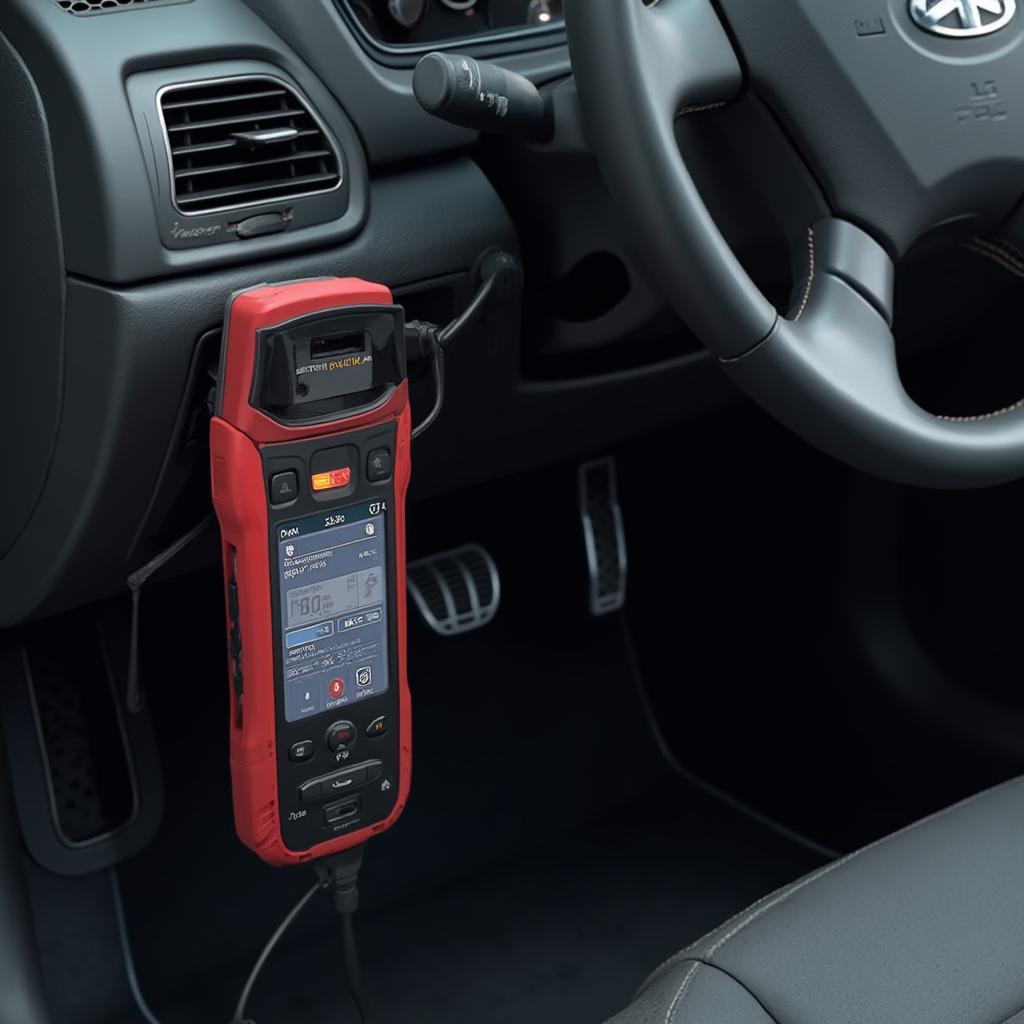The obd2 protocol is the backbone of modern vehicle diagnostics. It allows mechanics and car enthusiasts alike to tap into a vehicle’s electronic control units (ECUs) and retrieve a wealth of information about its performance and health. Understanding this protocol is key to unlocking the full potential of your OBD2 scanner.
What is the OBD2 Protocol?
The OBD2 protocol, or On-Board Diagnostics, version 2, is a standardized communication system that allows external devices, like OBD2 scanners, to access a vehicle’s diagnostic data. This data ranges from simple engine speed readings to complex emissions information. It’s the reason your mechanic can quickly diagnose a check engine light. Think of it as the common language spoken between your car and the diagnostic tool. What is the purpose of the obd2 protocol? It helps identify and resolve vehicle issues, improving performance and reducing emissions.
 OBD2 Scanner Connected to Car
OBD2 Scanner Connected to Car
Understanding Different OBD2 Communication Protocols
While OBD2 is a standard, there are actually several different communication protocols within the overall OBD2 framework. These include ISO 9141-2, KWP2000, PWM, VPW, and CAN. Each protocol uses a slightly different method for transmitting data, and knowing which one your car uses can be crucial for proper diagnosis. Why are there multiple obd2 protocols? Different manufacturers adopted different protocols before standardization, and OBD2 accommodates this variety. obd2 communication protocol offers further insights.
How to Determine Your Vehicle’s OBD2 Protocol
Finding your car’s specific OBD2 protocol might require a little detective work. You can sometimes find it listed in your owner’s manual, or use an online OBD2 protocol lookup tool. Many OBD2 scanners automatically detect the protocol upon connection. Why is knowing my car’s protocol important? It ensures compatibility with your chosen OBD2 scanner and accurate data retrieval.
Common OBD2 Protocol Issues
Like any communication system, the OBD2 protocol can sometimes encounter issues. These problems can range from loose connections to software glitches within the scanner itself. Understanding these potential issues can save you time and frustration.
Troubleshooting OBD2 Protocol Problems
When dealing with OBD2 protocol problems, the first step is always to check the basics. Ensure the scanner is properly connected to the OBD2 port and that the vehicle’s ignition is on. If the problem persists, consulting a professional mechanic might be necessary. What are some common causes of obd2 protocol errors? Faulty wiring, a blown fuse, or incompatibility between the scanner and the vehicle’s protocol can all contribute to issues. understanding the obd2 protocol explains these in more detail.
The Future of OBD2 Protocols
The OBD2 protocol continues to evolve alongside advancements in automotive technology. With the rise of electric vehicles and increasingly complex electronic systems, the future of OBD2 likely involves faster data transfer speeds and more sophisticated diagnostic capabilities. What’s the future of obd2 protocols? Emerging trends point towards increased data complexity and potentially new protocols designed for electric and autonomous vehicles. protocolos de comunicación obd2 pdf might provide further reading on this topic.
Conclusion
Understanding the obd2 protocol empowers you to take control of your vehicle’s diagnostics. Whether you’re a DIY mechanic or simply a curious car owner, knowing how this system works opens the door to a wealth of information about your car’s performance and health. obd2 port extension cable can be helpful for easier access. For specific protocols like those used by Nissan, check obd2 protocol for nissan.
FAQ
- What does OBD2 stand for? OBD2 stands for On-Board Diagnostics, version 2.
- Why is my OBD2 scanner not connecting? Several reasons can cause this, including a loose connection, a blown fuse, or protocol incompatibility.
- How do I find my car’s OBD2 protocol? Check your owner’s manual or use an online lookup tool.
- Can I use any OBD2 scanner on any car? While most scanners are compatible with a wide range of protocols, ensuring compatibility with your specific car’s protocol is important.
- What is the CAN protocol? CAN (Controller Area Network) is a high-speed OBD2 communication protocol common in modern vehicles.
- What are the benefits of using an OBD2 scanner? It allows you to diagnose car problems, monitor performance, and potentially save money on repairs.
- Are all OBD2 protocols the same? No, there are several variations, including ISO 9141-2, KWP2000, PWM, VPW, and CAN.
Expert Insight: “Understanding the underlying communication protocols is crucial for effective vehicle diagnostics,” says automotive engineer, Dr. Emily Carter.
Expert Insight: “The correct OBD2 scanner and protocol knowledge can empower car owners to troubleshoot issues proactively,” adds mechanic, Mr. David Miller.
Need help? Contact us via WhatsApp: +1(641)206-8880, Email: [email protected] or visit us at 789 Elm Street, San Francisco, CA 94102, USA. We have a 24/7 customer support team.

